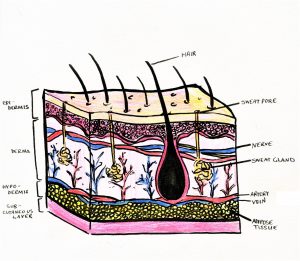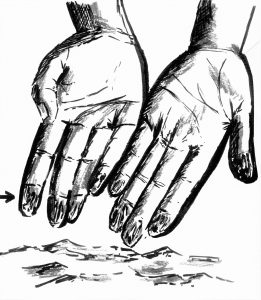
Author: Layal Bou Abdo, MSN
Illustrator: Angeline Boswell
15/06/2020
This remains a mystery! “Pruney” fingers and toes are another representation of wrinkles when you take a bath!
The wrinkles on your skin happen when you stay in the bath or soak your hands or feet for around 5 min in warm water, and it also happens faster with hotter water. The wrinkles last for around 3.5 minutes after you dry your hands and feet.
It only happens with your hands and feet and not with the rest of your skin.
Did you know that macaques also have pruney fingers and toes after constant exposure to water?
What the skin is made of?

Two layers of tissues make up your skin, the epidermis and the dermis.
- The epidermis is the outside part of the skin.
The epidermis has 4 layers. It consists of an outer shield of dead cells called the stratum corneum. The deeper section of the epidermis, or the basal layer, consists of rapidly dividing cells. When you perform certain activities, dead cells from the stratum corneum get damaged or scraped off. Yet, cells from the basal layers rise to replace them. The epidermis serves as the body’s initial barrier to invading foreign substances.
Pores are small openings in the skin that release oils and sweat. They’re also connected to your hair follicles
Keratinocyte is the main skin cell that makes up the epidermis, named this way because it produces a tough protein called keratin. It gives your skin much of its resistance to physical wear and tear and makes skin waterproof.
- The dermis is the inside of the skin. It’s directly below the epidermis and it’s a thicker layer. Blood vessels, sweat glands, hair follicles (roots), and sebaceous glands, form the dermis. The sebaceous glands produce the sebum. This layer is also made of dense connective tissues. Embedded inside this layer are different kinds of important receptors:
- The Thermoreceptors regulate the body’s temperature as they detect a temperature change.
- Meissner’s corpuscles, or touch receptors.
- Free nerve endings that detect pain and tissue damage.
- Underneath this layer is a thin layer of fat that cushions your body (subcutaneous).
Why does the skin have wrinkles while taking a bath?
-
Theory 1! Bye Bye Sebum
- A special oil called sebum (say: SEE-bum) cover your skin. Sebum is found on the outermost layer of the skin. Sebum is a natural moisturizer and lubricant that protects your skin. It also makes your skin a bit waterproof. But staying in water for a long time washes away the sebum. Then, the water can penetrate the outer layer of your skin. The water cause skin to swell up and get puffy. And this is how you get wrinkles on your hands and feet when you take a bath.
Our critique of that theory is that if the sebum (oil) is dissolved when soaked in water, why do we not have wrinkles when we shower with soap? It’s well known that soap dissolves the oil!
-
Theory 2! Keratin, the naughty one
- The keratin in the epidermis (stratum corneum) loves the water. When you soak your hands in water, the keratin absorbs it and swells. The inside of the fingers, however, does not swell. This bunching up occurs on fingers and toes because the epidermis is much thicker on the hands and feet than elsewhere on the body. (The hair and nails, which contain different types of keratin, also absorb some water. This is why the nails get softer after bathing or doing the dishes.)
-
Theory 3! What Scientists Know Now?
-
- Researchers noticed that it didn’t happen to people with nerve damage in their fingertips or toes. That meant the wrinkling was part of an involuntary (automatic) response of the sympathetic nervous system.
- Pruney fingers occur when the nervous system sends a message to the blood vessels to shrink (vasoconstriction). Blood vessels are the tiny pipes that carry blood around your body. The narrowed blood vessels reduce the volume of the fingertips slightly, causing loose folds of skin that form wrinkles. And this is how we get wrinkles on our hands and toes when we take a bath.
This theory explains how the process happens but it does not clarify what stimulates the sympathetic nervous system.
-
Theory 4! Good grip/slipping prevention?

- Some scientists think wrinkling may give you a better grip in the water. This makes it easier for you to touch and hold wet objects with your hands. Your toes also wrinkle in water, and so maybe this helps you safely walk on wet surfaces. A great analogy to explain this theory is that smooth tires, such as the racing tire, provide the best grip in dry conditions. In wet conditions, however, rain treads are better. And the wrinkles in your skin act like those rain treads on wet surfaces.
- A very long time ago, this would have helped our ancestors dig and work in a wet environment to collect food from underwater, especially in fast-flowing water like in a river.
- However, some scientists tested this idea and found having wrinkled fingers often did not improve the grip. So maybe this isn’t the answer after all.
- As for your toes, they haven’t tested those yet. But when you have to move fast on wet ground, wrinkly toes might have better gripping qualities too. And that might have made a difference to some distant barefooted ancestor fleeing a predator in the rain. It’s like those bumps at the bottom of your Pajama Footie or sock!
Let’s put this theory to the test.
Step 1: Try to take wet objects sunk in the water and move them to a dry surface as fast as you can!
Use a timer to note your speed.
Now soak your hands for at least 5 minutes in warm water until you have wrinkles.
Step 2: Repeat step 1 and note your time.
Were you faster or slower with wrinkled hands?
Do you have your best guess on why do we get wrinkles when we take a bath? Share with us your thoughts!
Why aren’t our fingers always wrinkly?
Wrinkles might make it easier for your skin to get injured or make it harder to feel the sensation.
A bonus question! Why do I get goosebumps?
Goosebumps serve no purpose in modern humans. It’s a physiological and emotional reaction that stimulates the adrenal gland in the body to produce adrenaline. The adrenaline causes the arrector pili muscle, which is attached to hair follicles, to contract. The contraction of this muscle leads to a shallow depression of the skin surface that causes everything around them to stand up, including our hair. This reflex is physiological and emotional. It occurs due to a sudden drop in temperature or feelings of panic, anger, or extreme fear. Goosebumps fluffed up the body hair of our ancestors who were much furrier or hairier to help trap heat or make them look larger to threatening animals. Today, goosebumps just make you look like you feel cold and you need to layer up. Goosebumps got their names because they resemble the goose skin underneath the feather.
Fun Facts about the skin!
Here are 8 facts about your skin:
- The skin is the largest organ of the body and it is an external coat.
- It makes up 16% of your body weight.
- It covers about 22 square feet (around 2 square meters).
- Your skin serves as an external guard for your inside organs and serves as a barrier that keeps germs and dirt out preventing them from entering your body.
- It protects your body and keeps it from drying out.
- Skin can also help keep you cool during hot weather and warm during cold weather. In cold conditions, your skin’s blood flow drops very low – retaining heat in the centre of the body and preserving the flow of warm blood to the important organs within the body. Skin and the fat layer beneath it also act as good insulators. When in a hot environment, or when generating heat from muscle activity, skin vessels open up – potentially increasing skin blood flow and you sweat. The skin, therefore, turns into a heat radiator. The evaporation of sweat from the skin cools the body down.
- The skin sheds 50000 dead skin every single minute and totally replenishes itself every 4 weeks.
- Skin is thickest on the palms and soles of the feet (1.5 mm thick), while the thinnest skin is found on the eyelids (0.05 mm thick).
Do you want to learn more about the skin and its diseases and how you can make your own skin model? Inquire about our teens’ program.
https://youtu.be/S12dlwQxOHw
We are certain your kid asks you health (human & animal) questions that genuinely leave you stumped! Leave a comment below and we are happy to answer “why” in future blogs.
Copyright © 2020 Little Medical School Ottawa

[…] Between the 6-7 weeks of the fetus’s development, the fetus starts to get some thick pads on his palms and feet. Those pads are called Volar Pads. Volvar Pads appear when special kind STEM cells (cells that can produce a different kind of cells) swell beneath the existing layers of the skin. […]
[…] things that carry diseases between animals and humans. When the female mosquito bites into our skin, it also injects a bit of saliva into our blood to prevent it from clotting. A red bump or a welt […]
[…] sweat is your natural air-condition. Your skin sweats to cool you off when you exercise or get hot. If […]